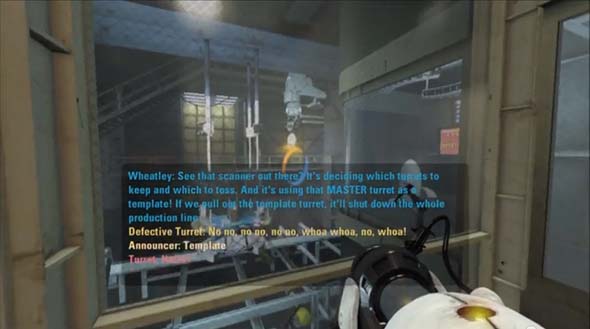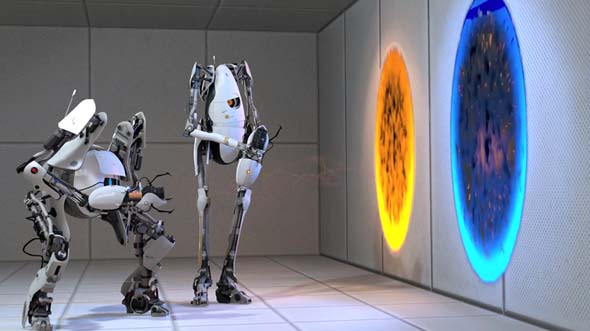This review was originally published 05/15/2011 on Game Observer (now defunct as of 05/13/2014). It has been republished here for archival purposes.
To be perfectly honest, I wasn’t looking forward to this game. I love the first Portal, as it was about as close to "perfect" as any game has ever come, but I couldn’t help but fear that Valve might turn this into a franchise, and in doing so, some of the allure of the game would be lost. But the game was released, and it is a triumph. Mostly.
Apparently, a very long time has passed since the first game. The Enrichment Center is very different. Under the care of the watchful AI, Wheatley, the entire facility has been slowly falling apart. The degrading, decrepit test chambers make for much more interesting visuals than the sterile, white and gray chambers of the first game. They are now overgrown with weeds and vines, panels are falling off the walls, broken glass litters the floors, and fallen and bent metal beams and girders obstruct some of your paths. It’s just too bad that with all the debris and vegetation littering the environment, that none of it is interactive. It slightly breaks the immersion when you walk through dangling leaves and they don’t react to your passing at all.
The Enrichment Center has seen better days.
There is a lot of visual variety in this game. You travel through the dilapidated chambers of the early game until the facility begins to rebuild itself. You watch it piece itself back together. Then you get to travel through the deepest guts of Aperture Science. And finally, you come back to see the test chambers tear themselves apart again
A bigger portal
The puzzles themselves are pretty much what you’d expect from a sequel to Portal. There are plenty of new props and toys to play around with, and the newly reactivated GladOS has new toys like lasers and tractor beam emitters to add some complexity to the puzzles. It felt a little bit like LittleBigPlanet 2 in that many of the puzzles rely too heavily on its new props to add variety to the game. But it doesn’t really make things that much harder, especially since the game usually points you in the right direction and marks locations where you are supposed to place portals.
In fact, the game’s puzzles seem to be a bit more constrictive than in the previous game. There wasn’t as much freedom for the player to find multiple solutions. The game also now requires you to commit violence in order to progress with some puzzles. This is in stark contrast to the first game, in which the player could make it through the whole game without having to "kill" anything (except, of course, for GladOS herself). This time, you will actually be required from time to time blow up gun turrets with lasers or drop them into bottomless pits.
The real increase in challenge doesn’t come from the new props or the fact that you actually have to kill enemies this time around. Instead, they come from the increased size and scale of the individual tests that the new propulsion gels allow. Sometimes, the areas are just so big that you can’t even find where to go or what to do because it is so far away.

Killing turrets is now mandatory for progression in certain puzzles; one of several ways that the game restricts the player's ability to creatively solve a problem.
Interface changes also help and hurt the game. On the one hand, you can now see your portals through walls. But on the other hand, Valve took away the indicator on the reticule that tells you whether or not a portal can be placed on a particular wall. This might seem unnecessary since portalable walls are white and non-portalable walls are gray or black, but it actually did get me killed! Some areas of the game are very finicky about whether or not a portal can be placed, and if you’re off center by a degree or two, you miss. If the puzzle happens to be timing-based, then you’ll probably die or have to restart the test. They also got rid of the little indicator on the reticule that tells you which portal was placed last, but since the gun changes colors based on which portal was placed last, that particular indicator isn’t really necessary.
But there was one thing that really bothered me about this game: it has loading screens! I don’t remember the first Portal having loading screens. It streamed from the disk, if I recall correctly. Maybe every now and then it had to stop for a few seconds to do that streaming, but the game flowed much smoother than Portal 2. I’m sure Valve had good reasons for doing this (the larger, more detailed environments probably played a big factor), but it is a sadly immersion-breaking technological step backwards.
Like all puzzlers, once you know the solution…
The game’s narrative adds a great deal of backstory, and is full of humor. GladOS is her charming self, and is even more abusive than before. Wheatley is a pleasantly entertaining goofball. And the J.K. Simmons-voiced Cave Johnson is a hoot, and is more than happy to tell you exactly what you’re supposed to do when life hands you lemons!
My only real complaint with the game’s narrative is that it makes the solution to the final boss battle way too obvious. It would have been very nice to have to figure out for myself what I’m supposed to do, especially considering that the game does give you hints throughout the course of the testing. Although it won’t help me, I really hope that Valve updates the game so that it doesn’t point you directly at the solution!
I was also pleased that the single player campaign actually does end in a way that does not necessitate another sequel. In fact, Portal 2 wraps up everything very nicely, so I am hopeful that my fear of a Portal franchise will not come to pass.

The co-op puzzles are fun, but not terribly replayable.
But Portal 2 isn’t just a single-player game. There is a cooperative multiplayer mode as well. It’s fairly short, but satisfying. The only problem is that once you know the solutions, it really isn’t all that interesting to play again with another friend. It was also very irritating that the game uses its own microphone chat system, instead of going through the Steam one. This lead to a bit of confusion setting up my first co-op game, and resulted in me having to reset my push-to-talk settings through Portal 2‘s options screen. It was a minor irritation that really could have been avoided, since Valve created both Portal 2 and Steam, and there should not have been a conflict to begin with.
If you purchased the PS3 version, you also get a code to unlock the whole game on the PC through Steam. This came in very handy with the PSN going down due to a cyber attack the day after the game was released. It’s almost as if Valve knew in advance that Sony was going to be hacked…
PSN trophies and Steam achievements can be earned simultaneously. But since the PSN still isn’t reactivated yet, I have no idea if the trophies I earned during my single player campaign on the PS3 will be copied onto Steam, or if the achievements I unlocked during cooperative play on the PC will be copied over to the PS3, once the PSN is brought back online. The game is supposedly cross-platform compatible, but since the PSN was down, I didn’t get to test that, but some of my friends did get cross-platform multiplayer games going before the network shut down. So it does work.
The game also includes a Steam interface on the PS3 that includes the Steam Cloud. This allows you to save you game to the Steam Cloud and play on any PS3. Unfortunately, however, the PC and PS3 save files are not compatible with one another (as some people mistakenly reported prior to release), so you can’t save to the Steam Cloud on the PS3 and then pick up from that spot on the PC.
I wish all games had a Cloud save feature. I recently had to send in my PS3 to Sony for repairs, and they sent back a replacement unit instead of fixing the one I had. And since some games have copy-protected save files, and Sony doesn’t allow copy-protected content to be copied from one system to another (even if you do a full backup, deactivate your old system, and reactivate the new one), I lost several games’ saves. So I hope that Portal 2 sets a precedent for the option for Cloud-based game saves that other developers and games will follow in the future. Especially games that have copy-protected save files! That way, I won’t have to go through this horror story again.
Summary
Portal 2 takes a few sidesteps in the technical and design departments, but those are minor irritation that don’t take away from an otherwise enjoyable experience. But I still hope that this game closes the book on the Portal franchise so that this shining star does not fade into an obligatory annual (or bi-annual) release (>cough< Kingdom Hearts >cough< Guitar Hero).